 advertisements advertisements
|

|
To Bennu and back: OSIRIS-REx asteroid sample mission launches
September 8, 2016 — For the first time since the last Apollo moon landing, a U.S. spacecraft is now on its way to collect and return samples from the surface of another celestial body.
OSIRIS-REx, or Origins, Spectral Interpretation, Resource Identification, Security, Regolith Explorer, embarked on the first NASA mission to retrieve a part of an asteroid.
The probe launched Thursday (Sept. 8) at 7:05 p.m. EDT (0005 GMT Sept. 9) on a United Launch Alliance Atlas V rocket from Space Launch Complex 41 at Cape Canaveral Air Force Station in Florida.
"Liftoff for OSIRIS-REx, its seven-year mission to boldly go to the asteroid Bennu and back," NASA commentator Mike Curie announced, offering a nod to the 50th anniversary of "Star Trek."
Fifty-nine minutes after it left the Earth, the solar-powered spacecraft separated from the Atlas's Centaur upper stage and began its voyage to "Bennu," a carbonaceous asteroid with a top layer of regolith — dust, small rocks and and soil — that may record the earliest history of our solar system.
"Sample return is at the forefront of scientific exploration," Dante Lauretta, OSIRIS-REx principal investigator with the University of Arizona, said at a press conference. "Not only are we going to get this material into our laboratories for chemical analyses that cannot be duplicated by spacecraft instruments, but this is going to [deliver] a treasure trove of information and material for scientists yet to come."
To Bennu and back
At the point that OSIRIS-REx launched, its target, Bennu, was 140 million miles (225 million km) from Earth. But to reach the asteroid and return samples, the spacecraft will travel about 4.5 billion miles over the next seven years.
OSIRIS-REx will spend its first year orbiting the sun before performing a flyby of Earth on Sept. 22, 2017 to gain the energy needed to change its orbital plane to match that of the asteroid (a difference of six degrees). Departing Earth for the second and last time, OSIRIS-REx will sling out into deep space on its way to an August 2018 rendezvous with Bennu.
Arriving at its destination, the probe will dedicate another year to surveying the surface of the 1,614-foot (492 meter) roughly-spherical rock, observing and studying it using its variety of instruments. OSIRIS-REx will map Bennu using optical cameras and a laser altimeter. The spacecraft will also use infrared and thermal emission spectrometers to generate mineral and organic maps in order to identify the best location to collect samples.
Instead of landing on the asteroid, OSIRIS-REx will extend a robotic arm, called the Touch-and-Go Sample Acquisition Mechanism (TAGSAM), to retrieve regolith. Designed and built by Lockheed Martin, the TAGSAM will release a burst of nitrogen gas, collecting a sample by causing loose rocks and dust to be stirred up and blown into the sampler head located at the end of the robotic arm.
The sample collection, which is targeted for July 4th, 2020, is intended to obtain at least 2 ounces (60 grams) and as much as 4.4 pounds (2 kg) of asteroid material. The cache will be stored in a canister in OSIRIS-REx's sample return capsule for the trip back to Earth.
Once the sample is confirmed as aboard, OSIRIS-REx will loiter in proximity of Bennu, waiting for Earth to align for it to begin its 2.5-year return journey in March 2021.
On Sept. 24, 2023, the spacecraft will release the sample capsule to parachute to a landing at the Test and Training Range in Tooele County, Utah. Using the same design as the Stardust sample return capsule that delivered material from Comet Wild 2 in 2006, the OSIRIS-REx capsule will hit the atmosphere at more than 27,000 mph (43,450 kp/h) using an ablative shield much like the Apollo spacecraft that landed from the moon 45 years ago.
The samples collected by OSIRIS-REx will be stored and studied inside the same facility that holds the Apollo moon rocks at Johnson Space Center in Houston.
Treasure trove of material
"This will be the largest sample-return mission since the Apollo era," Christine Richey, OSIRIS-REx deputy program scientist at NASA Headquarters in Washington, D.C., said.
Under cooperative agreements, half a percent of the total returned material will be provided to the Japan Aerospace Exploration Agency, which in turn will share samples from its already underway Hayabusa 2 sample return mission to asteroid Ryugu, and four percent will be shared with the Canadian Space Agency, in return for furnishing the laser altimeter on OSIRIS-REx.
Of the remaining 95.5 percent, three-quarters will be put into storage for the future, with the remaining 25 percent of the samples distributed to U.S. scientists for study.
Bennu – which was named by a 9-year-old contest winner, Michael Puzio of North Carolina, who thought OSIRIS-REx resembled the Egyptian drawings of a heron – is thought to harbor carbon organic molecules, the building blocks of life.
"One of the leading theories for delivery of organic material to the surface of the Earth is delivery from asteroids and comets," stated Lauretta. "Meteorites, once they are on the surface of Earth, are quickly contaminated – organically. Microbes love these materials. The things we're looking for are the things these bacteria are made out of, the amino acids that make up their proteins."
In addition to bringing back samples, OSIRIS-REx will also study how solar heating and cooling of Bennu altered its trajectory, referred to as the "Yarkovsky Effect." This is of particular interest with Bennu, given it is projected to pass close to the Earth — slightly within the orbit of the moon — in 2135. |
|
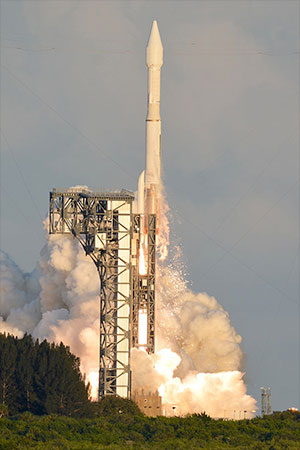
A United Launch Alliance Atlas V rocket lifts off with NASA's first asteroid sample return mission, OSIRIS-REx. (collectSPACE)
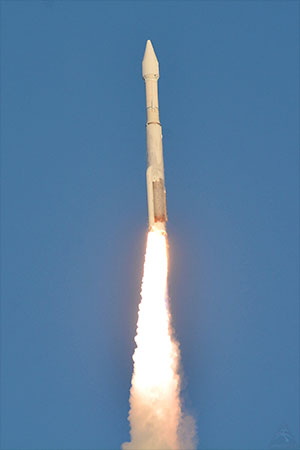
OSIRIS-REx soars spaceward atop the Atlas V. (collectSPACE)
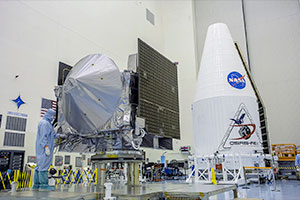
The OSIRIS-REx spacecraft is seen being prepared for launch on a mission to asteroid Bennu. (LaunchPhotography.com/Ben Cooper)
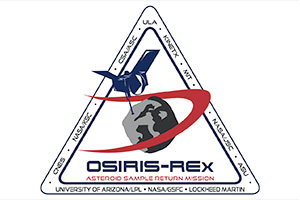
OSIRIS-REx Asteroid Sample Return Mission logo. (NASA) |
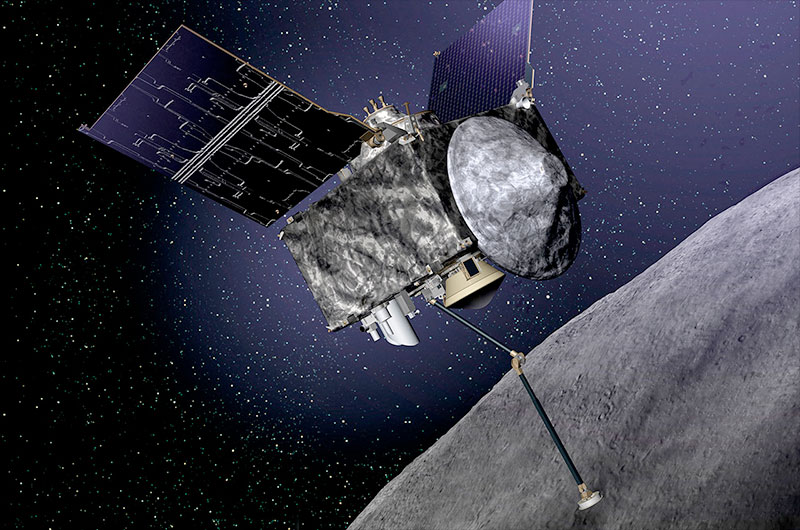
Rendering of the OSIRIS-REx (Origins, Spectral Interpretation, Resource Identification, Security, Regolith Explorer) probe at asteroid Bennu. (NASA) |
|

© collectSPACE. All rights reserved.
|
|

|

|
